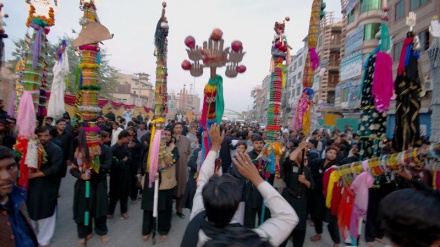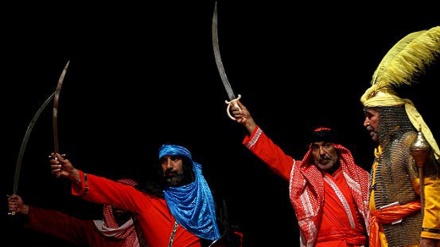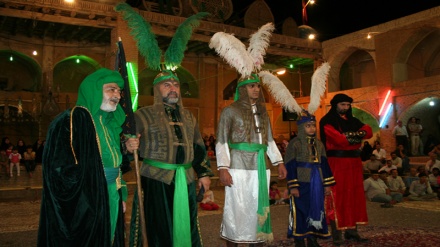Muharram mourning traditions in different lands - 32
In this series, which delves into the mourning traditions associated with the Immortal Epic of Ashura, we have been focusing on the various norms prevalent in different towns and cities of Iran for commemorating the heartrending tragedy of Karbala, after having dwelt on the history of mourning in different countries of the world for Imam Husain (AS).
Today we talk about the tradition of “clinking of shovels” and a separate tradition of “rattling of sticks”. These are observed in different regions of Iran, during the mourning months of Muharram and Safar.
Let us now take a closer look at the tradition of “clinking of shovels”. In Persian this tradition of mourning is known as “Beel-Zani”, and is performed on the day of Ashura (10th of Muharram) in the town of Khousef in south Khorasan Province in eastern Iran. The ceremony signifies the endless love, devotion, and reverence which the followers of the Prophet’s Ahl al-Bayt have for the Chief of Martyrs, Imam Husain (AS). The “Beel-Zani” ceremony is performed by local residents of Khousef, many of them farmers, on the day of Ashura, in the town’s main Husseiniyeh.
Each person brings along a shovel, and in groups of two or more individuals, the tips of the shovels are struck rhythmically on the ground, creating a sound which reminds the mourners of the fierce clash of steel during the Battle of Karbala in 61 AH on the 10th of Muharram!! The sound of shovels striking one another on the day of Ashura, creates a wonderful cacophony, which symbolizes the battle between good and evil, the battle between the forces of the Godless tyrant Yazid, and the forces of truth and righteousness, led by Imam Husain (AS).
The farmers of Khousef, who chant mournful elegies during this ceremony, believe that this is their way of expression of grief for the Prophet’s grandson. They say that it symbolizes their devotion to the Imams of the Ahl al-Bayt. This ceremony has been passed down from their ancestors, say the people of Khousef.
Another mourning ceremony which is performed during Muharram in parts of Iran is Chak Chakou or “rattling of sticks”. This ceremony has several other names, and is widespread in Fars Province. People hold sticks in their hands, and rhythmically wave them in the air to the chanting of elegies, as a form of expressing their grief for the martyrs of Karbala.
In parts of Isfahan and Yazd Provinces, there is another tradition of mourning known as “Chaq-Chaqi Zani”. Two 10-centimeter rounded pieces of wood, and sometimes of stone, are rhythmically beaten on the chest, as elegies are chanted.
According to oral traditions, the origins of this ceremony go back to the Bani Assad tribe that inhabited the surroundings of Karbala in the time of Imam Husain (AS). Members of this tribe arrived at the scene of the tragedy of Karbala, three days after the martyrdom of the Prophet’s grandson, and seeing the headless and mutilated bodies of the Imam, his family and friends, they started to hit their chests and heads with stones in greif.
This explains the origin of this mourning ceremony. Over the years wood has replaced stone in this mourning ceremony. This ceremony is also performed in Damghan, in Semnan province in eastern Iran, and surrounding villages. In parts of India, these pieces of wood have nails with which the mourners beat their chest and blood comes out. In Iran, however, such deliberate physical harm is forbidden.
Today we talk about the tradition of “clinking of shovels” and a separate tradition of “rattling of sticks”. These are observed in different regions of Iran, during the mourning months of Muharram and Safar.
Let us now take a closer look at the tradition of “clinking of shovels”. In Persian this tradition of mourning is known as “Beel-Zani”, and is performed on the day of Ashura (10th of Muharram) in the town of Khousef in south Khorasan Province in eastern Iran. The ceremony signifies the endless love, devotion, and reverence which the followers of the Prophet’s Ahl al-Bayt have for the Chief of Martyrs, Imam Husain (AS). The “Beel-Zani” ceremony is performed by local residents of Khousef, many of them farmers, on the day of Ashura, in the town’s main Husseiniyeh.
Each person brings along a shovel, and in groups of two or more individuals, the tips of the shovels are struck rhythmically on the ground, creating a sound which reminds the mourners of the fierce clash of steel during the Battle of Karbala in 61 AH on the 10th of Muharram!! The sound of shovels striking one another on the day of Ashura, creates a wonderful cacophony, which symbolizes the battle between good and evil, the battle between the forces of the Godless tyrant Yazid, and the forces of truth and righteousness, led by Imam Husain (AS).
The farmers of Khousef, who chant mournful elegies during this ceremony, believe that this is their way of expression of grief for the Prophet’s grandson. They say that it symbolizes their devotion to the Imams of the Ahl al-Bayt. This ceremony has been passed down from their ancestors, say the people of Khousef.
Another mourning ceremony which is performed during Muharram in parts of Iran is Chak Chakou or “rattling of sticks”. This ceremony has several other names, and is widespread in Fars Province. People hold sticks in their hands, and rhythmically wave them in the air to the chanting of elegies, as a form of expressing their grief for the martyrs of Karbala.
In parts of Isfahan and Yazd Provinces, there is another tradition of mourning known as “Chaq-Chaqi Zani”. Two 10-centimeter rounded pieces of wood, and sometimes of stone, are rhythmically beaten on the chest, as elegies are chanted.
According to oral traditions, the origins of this ceremony go back to the Bani Assad tribe that inhabited the surroundings of Karbala in the time of Imam Husain (AS). Members of this tribe arrived at the scene of the tragedy of Karbala, three days after the martyrdom of the Prophet’s grandson, and seeing the headless and mutilated bodies of the Imam, his family and friends, they started to hit their chests and heads with stones in greif.
This explains the origin of this mourning ceremony. Over the years wood has replaced stone in this mourning ceremony. This ceremony is also performed in Damghan, in Semnan province in eastern Iran, and surrounding villages. In parts of India, these pieces of wood have nails with which the mourners beat their chest and blood comes out. In Iran, however, such deliberate physical harm is forbidden.


